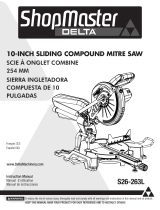
ENGLISH
24
1. Parts Identification
(standard delivery)................. 23
2. Please Read First!..................24
3. Safety ......................................24
3.1 Specified conditions of use ...... 24
3.2 General safety instructions ...... 24
3.3 Symbols on the machine .........26
3.4 Safety devices .........................26
4. Installation and Transport.....27
4.1 Installation................................27
4.2 Installing the table extension ...27
4.3 Mounting the cutting
depth limiter .............................28
4.4 Transport .................................28
5. Special Product Features......28
6. Initial Operation .....................28
6.1 Installing the dust extraction
adapter..................................... 28
6.2 Mounting the rotary table lock
screw ....................................... 29
6.3 Installing the work clamp .........29
6.4 Mains connection.....................29
7. Operation................................ 29
7.1 Using the laser guide ............... 29
7.2 Adjusting the saw blade
speed .......................................30
7.3 Mitre cuts ................................. 30
7.4 Bevel cuts ................................ 31
7.5 Compound mitre cuts...............31
7.6 Cutting of small cutoffs ............32
7.7 Grooving ..................................32
7.8 Cut dimensions for
various cuts.............................. 32
8. Care and Maintenance...........33
8.1 Saw blade change ................... 33
8.2 Replacing the table insert ........ 34
8.3 Drive belt tensioning ................ 34
8.4 Adjustments ............................. 34
8.5 Cleaning the machine .............. 36
8.6 Storage ....................................36
8.7 Maintenance ............................36
9. Tips and Tricks ......................36
10. Available Accessories......37/76
11. Repair......................................37
12. Protection of the
Environment...........................37
13. Troubleshooting ....................37
14. Technical Data .......................38
These instructions have been written in
a way which facilitates learning of how
to operate your saw safely. These in-
structions should be used as follows:
– Read instructions before use. Pay
special attention to the safety infor-
mation.
– These instructions are intended for
persons with basic technical knowl-
edge regarding the operation of a
device like the one described here-
in. If you have no experience what-
soever, you are strongly advised to
seek competent advice and guid-
ance from an experienced person
before operating this machine.
– Keep all documents supplied with
the tool so that you and all other us-
ers can access them at any time.
Retain proof of purchase in case of
warranty claims.
– If you lend or sell this machine be
sure to have all machine documents
supplied go with it.
– The equipment manufacturer is not
liable for any damage resulting from
neglect of these operating instruc-
tions.
Information in this manual is denoted
as follows:
ADanger!
Risk of personal injury or environmental
damage.
BRisk of electric shock!
Risk of personal injury by electric
shock.
cDrawing-in/trapping hazard!
Risk of personal injury by body parts or
clothing being drawn into the rotating
saw blade.
A Caution!
Risk of material damage.
3 Note:
Additional information.
– Numbers in illustrations (1, 2, 3
etc.)
– indicate component parts;
– are consecutively numbered;
– relate to the corresponding num-
ber(s) in brackets (1), (2), (3) etc.
in the neighbouring text.
– Numbered steps must be carried
out in sequence.
– Instructions which can be carried
out in any sequence are marked
with a bullet (•).
– Listings are indicated by an en dash
(–).
3.1 Specified conditions of
use
This saw can be used for making rip
and cross cuts, bevel cuts, mitre cuts
and compound mitre cuts. It can also
be used for grooving.
Work only materials suitable for cutting
by the saw blade fitted (see 'Technical
Data' for available saw blades).
Do not cut workpieces unless they con-
form to the permissible dimensions
(see section 'Operation').
Stock having a round or irregular cross
section (such as firewood) must not be
cut as it cannot be securely held during
cutting. When sawing thin stock on
edge, use a suitable auxiliary fence for
firm support.
Any use other than the use specified
above is not allowed. Unspecified use,
modifications to the machine or use of
parts not tested and approved by the
equipment manufacturer may cause
unforeseeable damage!
3.2 General safety instruc-
tions
When using this machine observe
the following safety instructions to
minimize the risk of personal injury
or material damage.
Please also observe the special
safety instructions in the respective
sections.
Where applicable, follow the legal
directives or regulations for the pre-
vention of accidents pertaining to
the use of crosscut saws.
Table of Contents
2. Please Read First!
3. Safety




















